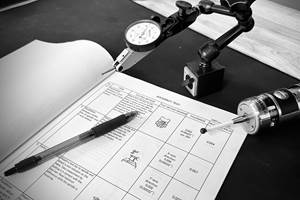Gaging Distance Between Hole Centers
Many of the gaging applications we've considered over the years involve size inspection of a single feature, that is, the diameter of a hole, depth of a groove, height of a gage block, and so on. Many parts, however, contain multiple features that establish dimensional relationships between two or more other parts.
Share





Takumi USA
Featured Content
View More
ECi Software Solutions, Inc.
Featured Content
View More




Many of the gaging applications we've considered over the years involve size inspection of a single feature, that is, the diameter of a hole, depth of a groove, height of a gage block, and so on. Many parts, however, contain multiple features that establish dimensional relationships between two or more other parts. Examples include engine blocks, with multiple cylinder bores that establish distances between pistons, and pump housings with two overlapping bores that establish clearance between two mating impellers. As with people, machined features tend to be simple and straightforward when they're single. When people or parts are in relationships, however (and especially when those relationships involve mating) things can get complicated.
Gaging the distance between hole centers is a good example, because it requires that you first locate those centers in space before you can measure the distance between them. Gaging equipment may vary widely with the application, and include considerations of part size and configuration, and required throughput and accuracy. But the basic idea remains the same across various technical approaches; you must first establish references between the part and the gage, often in three dimensions, before you can measure deviation from a specified distance between features.
A basic approach is a hand-held gage, like that shown in the figure. Both of the plugs have two fixed contacts, and one spring-loaded contact each, so they automatically center themselves in their respective holes. One of the plugs is a fixed reference; the other is a sensitive contact. Note also the hard depth stops, establishing a reference in the third dimension. The sensitive plug moves relative to the fixed plug on a frictionless device such as a pantograph mechanism or an air-bearing carriage for good repeatability. The sensing/indicating device used to measure deviation may be a simple dial or digital indicator, or an electronic probe and amplifier.
This gage is economical, reliable, and easy to use. It may be employed with parts as large as an engine block (or larger), or as small as a connecting rod, and its capacity may be adjustable to measure different distances. The plugs may be replaceable, to accommodate different size holes. Its limitation is that it only measures distances between centers; no other types of features or relationships may be checked.
The next option is a gaging fixture engineered for a specific part. Such gages are generally benchtop devices, so they are limited to use with relatively small parts (that is, automotive conrods) that can be brought to them. The workpiece is typically located over fixed plugs, each of which may contain one or more air or electronic probes as sensing devices. Fixture gages may offer limited adjustability, but tend to be very application-specific.
The benefit side of the coin, however, is substantial. Fixture gages tend to be very stable, and allow high throughput rates. Because the probes can be spaced quite densely within the fixture, it is possible to measure multiple features or characteristics simultaneously. For example, a conrod gage with sixteen probes (eight each for the wrist pin and the crankshaft bores) can be engineered to measure the following features, in addition to center distance between bores: four diameters per bore (6:00 to 12:00, and 3:00 to 9:00, at both top and bottom), bore "out of roundness" (that is, the difference between two diameters at right angles), bore taper, and bend and twist between bores. Gaging computers and some amplifiers can be readily programmed to perform all these measurements without changing the gaging setup.
Related Content
4 Ways to Establish Machine Accuracy
Understanding all the things that contribute to a machine’s full potential accuracy will inform what to prioritize when fine-tuning the machine.
Read MoreProcess Control — Leveraging Machine Shop Connectivity in Real Time
Renishaw Central, the company’s new end-to-end process control software, offers a new methodology for producing families of parts through actionable data.
Read MoreParts and Programs: Setup for Success
Tips for program and work setups that can simplify adjustments and troubleshooting.
Read MoreThe Link Between CNC Process Control and Powertrain Warranties
Ever since inventing the touch-trigger probe in 1972, Sir David McMurtry and his company Renishaw have been focused on achieving process control over its own manufacturing operations. That journey has had sweeping consequences for manufacturing at large.
Read MoreRead Next
5 Rules of Thumb for Buying CNC Machine Tools
Use these tips to carefully plan your machine tool purchases and to avoid regretting your decision later.
Read MoreSetting Up the Building Blocks for a Digital Factory
Woodward Inc. spent over a year developing an API to connect machines to its digital factory. Caron Engineering’s MiConnect has cut most of this process while also granting the shop greater access to machine information.
Read MoreBuilding Out a Foundation for Student Machinists
Autodesk and Haas have teamed up to produce an introductory course for students that covers the basics of CAD, CAM and CNC while providing them with a portfolio part.
Read More















.png;maxWidth=150)



























